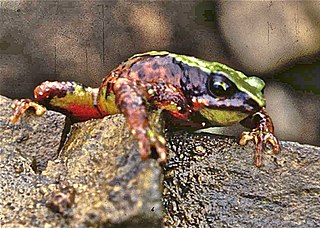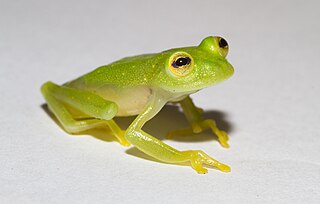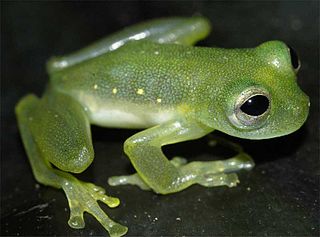 W
WAtelopus arthuri, Arthur's stubfoot toad, is a species of toad in the family Bufonidae endemic to Ecuador. Its natural habitats are subtropical or tropical moist montane forests, subtropical or tropical high-altitude grasslands, and rivers. It is threatened by habitat loss. It has not been seen for more than 20 years and is considered probably extinct.
 W
WAtelopus balios, the Rio Pescado stubfoot toad, is a species of toad in the family Bufonidae. It is endemic to southwestern Ecuador, with records from Pacific lowlands in Azuay, Cañar, and Guayas Provinces. It is a rare species that was already suspected to be extinct, but a single specimen was discovered in 2011 by a team from Conservation International during a hunt for missing amphibians. The decline in amphibian populations is well documented. The Atelopus balios is Critically Endangered as a result of the widespread amphibian Chytridiomycosis fungus that has decimated other amphibian populations. There are only 10 known findings of the tadpole, Atelopus balios.
 W
WBokermannohyla nanuzae is a species of frog in the family Hylidae. It is endemic to Brazil and known from the Serra do Espinhaço and Serra da Mantiqueira in the Minas Gerais state.
 W
WCochranella resplendens is a species of frog in the family Centrolenidae. It is found in the upper Amazon Basin in southern Colombia, eastern Ecuador, and San Martín Region of northern Peru. It is sometimes known as the resplendent Cochran frog.
 W
WThe Cordillera central tree frog is a species of frog in the family Hylidae found in Colombia and Ecuador. Its natural habitats are subtropical or tropical moist montane forests and rivers. It is threatened by habitat loss. While living, this creature has a solid brown dorsum, and its concealed limbs and underbelly are blue with black spots. The younger frogs are a grayish brown with some darker markings. The younger frogs' concealed limbs and underbellies are a creamy color.
 W
WThe Eungella torrent frog is a species of stream dwelling frog endemic to Australia. It is restricted to ranges west of Mackay in mid-eastern Queensland.
 W
WThe Plains leopard frog It is sometimes referred to as Blair's leopard frog, named after the noted zoologist and University of Texas professor, Dr. W. Frank Blair.
 W
WThe gastric-brooding frogs or platypus frogs (Rheobatrachus) is a genus of extinct ground-dwelling frogs native to Queensland in eastern Australia. The genus consisted of only two species, both of which became extinct in the mid-1980s. The genus is unique because it contains the only two known frog species that incubated the prejuvenile stages of their offspring in the stomach of the mother.
 W
WHyalinobatrachium pellucidum, also known as the Rio Azuela glass frog, is a species of frog in the family Centrolenidae. It is found in lower montane rainforests on the Amazonian Andean slopes in Ecuador and Peru. The specific name pellucidum is Latin for "transparent" and refers to the transparent parietal peritoneum of this species.
 W
WHyalinobatrachium vireovittatum is a species of frog in the family Centrolenidae. It is found in scattered localities in Costa Rica and west-central Panama. It has, however, been suggested that most populations actually represent Hyalinobatrachium talamancae, with Hyalinobatrachium vireovittatum restricted to its type locality in the San Isidro de El General district.
 W
WJulianus pinimus is a species of frog in the family Hylidae. It is endemic to Brazil. Its natural habitats are moist savanna, subtropical or tropical moist shrubland, subtropical or tropical high-altitude shrubland, subtropical or tropical dry lowland grassland, swamps, and intermittent freshwater marshes. It is threatened by habitat loss.
 W
WLithobates brownorum is a species of frog native to southern Veracruz and northeastern Oaxaca east through the Yucatan Peninsula and the uplands of Chiapas in southern Mexico through Guatemala and Honduras to Nicaragua. Its separateness from Lithobates berlandieri has been questioned but molecular data now supports the conclusion that it is a separate species.
 W
WNymphargus anomalus is a species of frog in the family Centrolenidae. It is endemic to Ecuador and occurs on the Amazonian slopes of the Ecuadorian Andes in the Napo Province. Common name Napo Cochran frog has been coined for it.
 W
WOlolygon machadoi is a species of frog in the family Hylidae. It is endemic to Brazil. Its natural habitats are subtropical or tropical moist lowland forests, subtropical or tropical moist montane forests, subtropical or tropical moist shrubland, and rivers. It is threatened by habitat loss.
 W
WRaorchestes shillongensis is a species of frog in the family Rhacophoridae. It is endemic to Greater Shillong in North East India. It is known from the Khasi Hills in the region of Shillong, Meghalaya in north-eastern India. It has been categorized as Critically Endangered because its extent of occurrence is less than 100 km², its distribution is severely fragmented, there is continuing decline in the extent and quality of its habitat, and in the number of mature individuals in and around Shillong, in Meghalaya, northeastern India.
 W
WScinax alter, the Crubixa snouted treefrog, is a species of frog in the family Hylidae endemic to Brazil. Its natural habitats are subtropical or tropical moist shrubland, subtropical or tropical seasonally wet or flooded lowland grassland, swamps, intermittent freshwater lakes, freshwater marshes, intermittent freshwater marshes, pastureland, and ponds.
 W
WSphaenorhynchus prasinus, or Bokermann's lime treefrog, is a species of frog in the family Hylidae. It is endemic to eastern and southeastern Brazil and occurs in the states of Pernambuco, Alagoas, Bahia, and Minas Gerais.
 W
WTeratohyla midas is a species of frog in the family Centrolenidae. It is found in the Amazon Basin of western Brazil, Ecuador, Peru, and Colombia. There are, at least seemingly, isolated occurrences in French Guiana and in Maranhão.